This ultimate guide to sourdough tips and troubleshooting will answer all of your sourdough FAQs… including what kind of flour to use, reviving a sourdough starter, converting recipes to sourdough, and more.
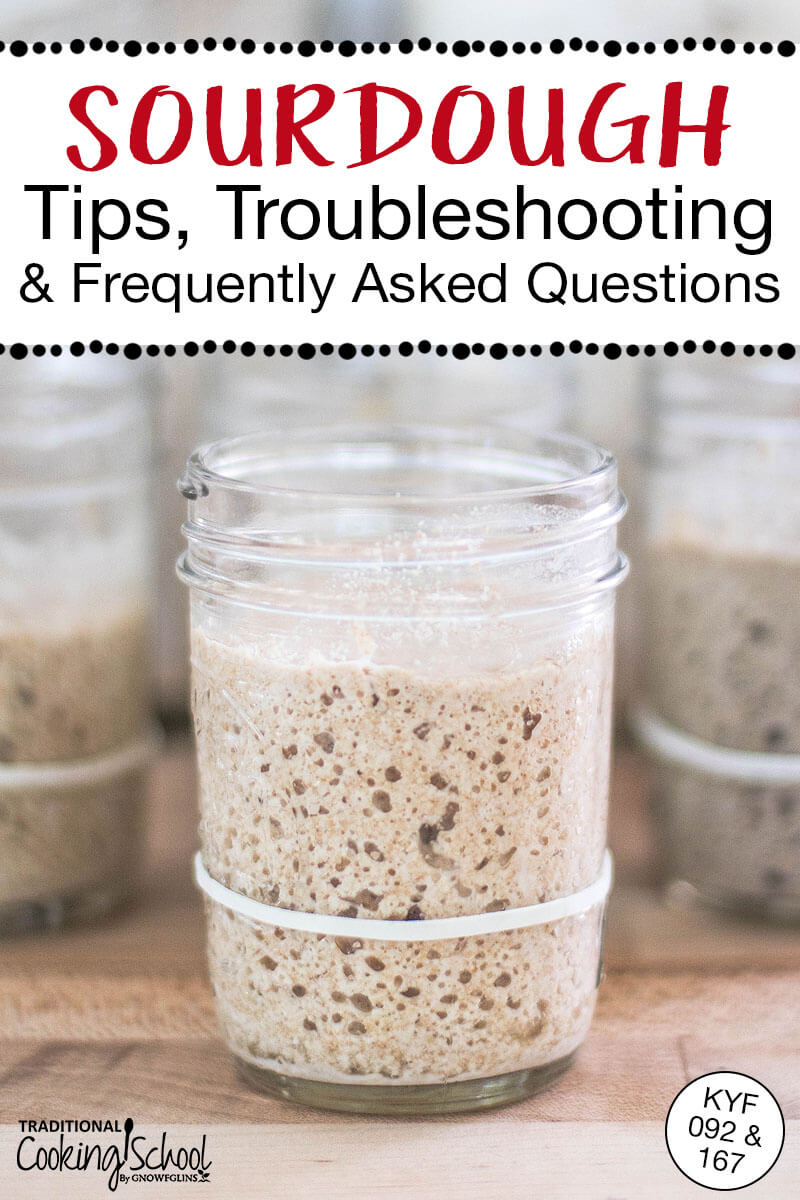
Years ago, I answered your sourdough questions in not one, but two Know Your Food with Wardee podcast episodes. I’ve received many more questions since then, so I decided it was time to combine and update those original posts!
Below you will find the original podcast episodes (092 and 167) in video and/or audio format, plus reader questions and my answers and sourdough tips written out for those of you who prefer the transcript.
Questions include:
- How to make a sourdough starter
- Reviving a starter that’s been stored in the fridge
- A low maintenance way to care for a starter
- What flours to feed your starter
- How often to feed your starter
- and many, many more sourdough tips and FAQs!
Table Of Contents
Sourdough Tips: Troubleshooting, FAQs & More!
Subscribe to the Know Your Food with Wardee podcast on iTunes, Stitcher, YouTube, or the Podcasts app.
KYF episode 167 “Sourdough Frequently Asked Questions”:
KYF episode 092 “Sourdough Questions Answered”:
Sourdough Frequently Asked Questions & Care Tips
If you’re interested in sourdough, be sure to grab my free sourdough starter instructions and tips! In 5 minutes, you could have a starter beginning to grow and flourish in your very own kitchen — that will serve you with delicious and healthy baked goods for a lifetime or more!
What is a sourdough starter?
All sourdough foods begin with a sourdough starter — an active colony of wild yeasts and Lactobacilli suspended in a batter of flour and water. The wild yeasts and Lactobacilli are everywhere — in the air, in unprocessed whole-grain flours, on your fruits and veggies, and on your skin.
Creating and maintaining a starter is a process of feeding the naturally present organisms to encourage them to multiply over and over until the jar is full of millions of them.
How do I make a sourdough starter?
I have a whole post written just for you! Learn how to make your own sourdough starter here. I also help you troubleshoot and answer your sourdough FAQs related to making a new sourdough starter from scratch.
And here’s how to make an einkorn sourdough starter!
Do I really have to discard my sourdough starter when first making it?
Yes… and I wrote a whole post about sourdough discard where I explain that it’s actually the most frugal way to make a sourdough starter, plus ideas for what to do with your sourdough discard instead of throwing it away.
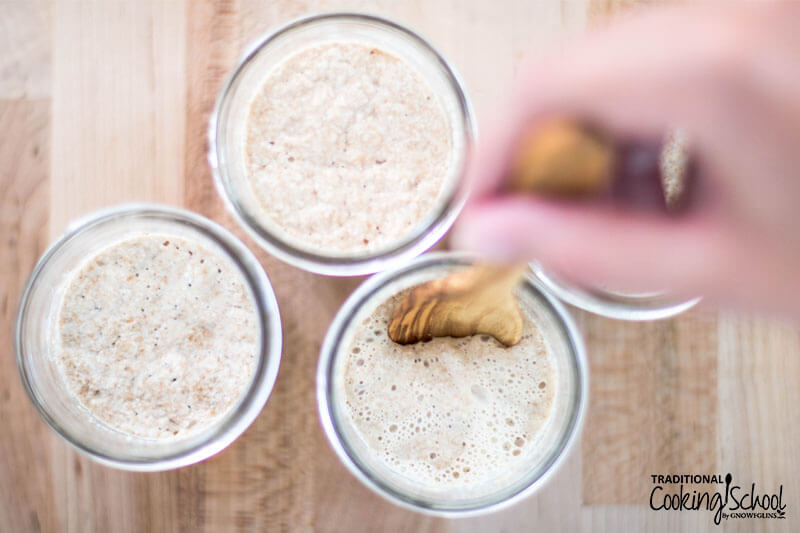
Is it true that I shouldn’t use a metal spoon with my sourdough starter?
As a general rule, use non-reactive materials such as glass or wood with sourdough. Of the different metals, however, I find stainless steel to be okay, as it is minimally reactive.
Avoid plastic containers because over time, the acidity of the starter can cause the plastic to leach into it. Always remember to choose a container that gives your starter room to double or triple in volume if it needs to!
Will you share your sourdough care routine with me?
Absolutely. I explain two sourdough care routines, one daily and one weekly, in this #AskWardee. And here is my personal routine of feeding my sourdough maintenance amounts, including tips for keeping things simple.
What type of flour can I feed my starter?
I am having an issue with too much fiber even with eating plenty of cultured food. Can I feed the starter with white flour or sifted whole grain? Will the starter will work well with this kind of flour on 2 feedings a day? -Pam F.
For new sourdough starters, my best tip is to use a whole grain flour (such as whole wheat, spelt, einkorn, or rye flour), preferably organic and definitely unbleached. You can also grind your own flour such as with the Mockmill.
Whole grain is preferred to all-purpose flour because it is more abundant in wild yeasts and lactobacilli, which we’re trying to catch and nurture into a starter. The process of refining flour removes the microorganisms, which are on the outer hull of the grain.
Once the starter is mature and established, it’s okay to use your all-purpose, white, or soft wheat flours.
For more information on the Mockmill, check out our Home Grain Milling 101 series. You can also visit this link for 5% off (no coupon code needed) your purchase of a Mockmill!
Can I feed sprouted flour to my sourdough starter?
Yes! The only thing to watch for with sprouted flour is that the grain is already partially broken down due to sprouting. This means your starter may run out of food faster and you might have to do feedings three times a day. You’ll know that’s the case if it’s producing a lot of hooch early on, rather than toward the 12 hour mark.
However… sourdough is the most effective method of traditional food preparation when it comes to deactivating anti-nutrients and enhancing nutrition, so there’s really no need to use sprouted flour in your starter or in sourdough baking.
Regular flour will yield the same results nutritionally, so you might want to save your sprouted flour for baking where sourdough isn’t an option. This will save you time (if you’re sprouting grains yourself) or money (if you’re buying sprouted flour).
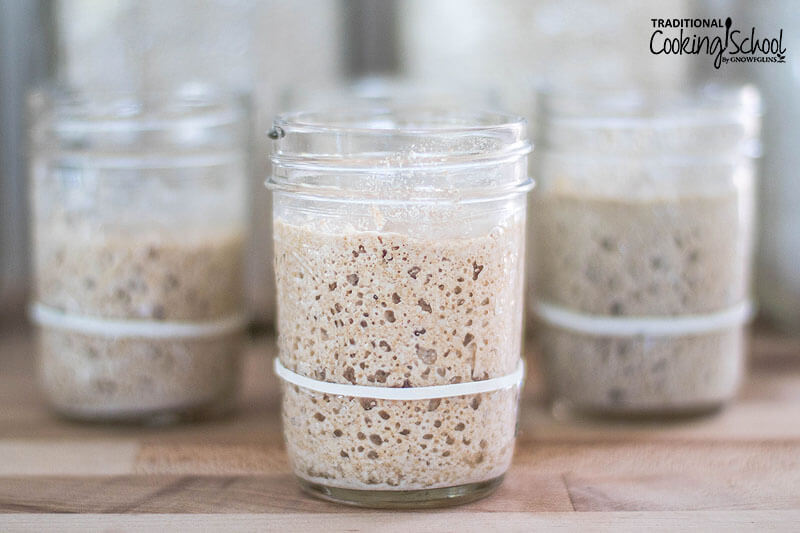
Do I have to keep feeding my starter the same flour, or can I switch?
Yes, you can switch flours. Here’s how to do it!
More specifically, I share how to transition a sourdough starter to einkorn flour here.
How should I store my flour before feeding it to my starter?
When you mill your whole wheat or einkorn flour and have leftover flour, do you leave the leftover flour at room temperature and use that to feed the starter everyday? I understand that it immediately starts to go rancid after it is milled. How many days can I leave it out of the refrigerator or freezer? I would think it is better to have it at room temperature to feed the starter rather than refrigerator or freezer temperature? -Pam F.
Room temperature flour is best when your starter is still young and not established. After it’s mature, you can feed it flour that has been kept in the fridge or freezer. I discuss the issue of room temperature flour and water here.
If you’d like to leave leftover flour out at room temperature just for feeding your starter, that’s fine. It’s hard to know how long it lasts before going rancid, but you’re not really using it for health at this point. Instead, it’s just a food source for the starter. So I’m not as concerned with how long as I would be if it was the bulk of the flour for the recipe.
Check out this past #AskWardee, where I share my daily sourdough routine. It will help!
How long does flour stay fresh?
Use flour within three days of grinding (room temperature), or refrigerate for up to seven days, or freeze up to six months. Milled grains should not be stored at room temperature for more than three days because of the danger of rancidity.
Sprouted flour should be used/stored similarly. Although it does last longer than unsprouted, we follow these guidelines to be on the safe side of rancidity.
Here’s more information on storage of grains and flour!
Can I feed my starter something other than flour?
Yes! Both cooked oatmeal and cooked rice can be used to feed your starter. More information here.
Does it matter what kind of water I give my starter?
Yes, it matters! The beneficial bacteria and yeasts in a sourdough starter may have trouble thriving in water contaminated with chlorine, chloramine, or flouride (among thousands of other contaminants found in city water). If your water is not clean or you don’t filter it, I recommend purchasing spring water or filtered water (here’s how to choose the best water filter for your family!).
If your water is filtered and does not re-add minerals back, consider fortifying it with natural mineral drops. I discuss using reverse osmosis water for sourdough in this #AskWardee.
I also recommend, if possible, giving your starter warm or room temperature water. It’s not a set-in-stone thing, but it is best practice. More information here.
Can I keep my sourdough starters next to each other, or do I need to separate them like other ferments?
You can keep them side by side. You might find they influence each other though, like one might behave better than the other or vice versa, until they get used to each other’s presence. That happened to me and my daughters; I share our story here.
My sourdough starter is very thick and pasty… is this okay?
Thick is totally fine, however, you can add a bit more water if it’s hard to stir. Somewhere between cake batter and cookie dough is a good consistency! All amounts are approximate and geography/humidity/flour variety has an impact on thickness.
Why isn’t my starter doubling in size? It looks so flat.
Not everyone gets doubling or tripling in volume. It depends on the flour and water ratio, among other things. To troubleshoot, try feeding your sourdough starter more flour than water for a stiffer, thicker consistency.
The other thing is, you might be missing when it gets high because often a starter collapses at the end of the 12 hour cycle. Don’t give up and don’t worry… if it’s bubbly and active, it’s doing great!
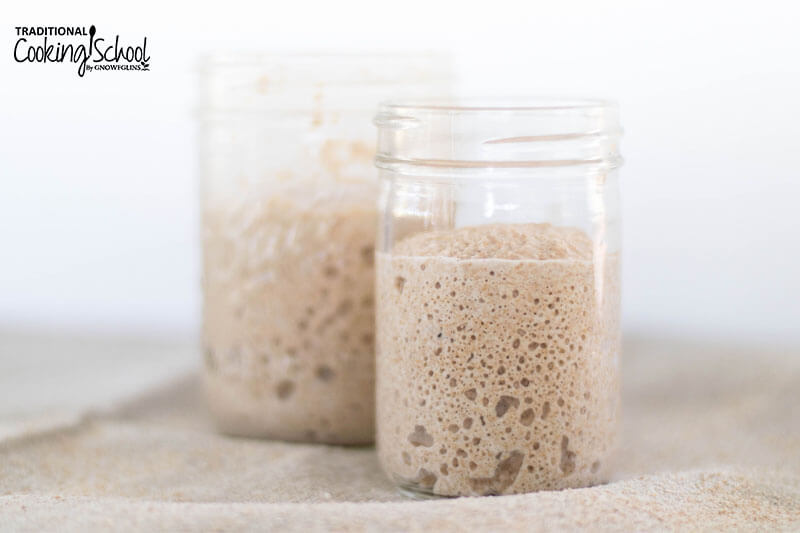
What does a starter in its active, domed state look like?
It has a curve on the top of it with lots of bubbles all around. This is considered “active” and ready to bake because it’s domed and bubbly and hasn’t begun to spill out hooch (yellow liquid). Spilling out hooch is a sign that it’s past the height of activity.
When is my sourdough starter mature and ready for baking bread?
If it’s bubbling, producing hooch, doming up/enlarging in size, and has a fresh/sour smell regularly for three weeks, sourdough is considered established and mature… at which time we say it’s ready for bread-making! Here are my best tips for baking sourdough bread that isn’t dense.
It’s also ready for maintenance feedings and refrigeration at this point.
Looking for sourdough bread recipes? Here are our favorites!
- Whole Grain Sourdough Bread (einkorn, spelt, or whole wheat)
- Not-So-Dense (Or Sour) Sourdough Bread
- Sourdough Sandwich Bread {made with einkorn, spelt, & oat}
If my starter isn’t ready for baking bread yet, is there anything else I can make with it?
Yes! Once your starter is five days old, use it in any of these easy, delicious sourdough discard recipes: fluffy pancakes, waffles, English muffins, crepes, chocolate cake, spice cake, or pizza crust — all free recipes right here at TCS.
My starter smells unpleasant, not the clean, sour smell you describe.
If your starter is new, off smells can be normal. The organism balance is shifting… please give it all time. Also, if you have your new starter near an established starter, this can cause it too.
If your starter has an alcohol smell, then you may have to do a little troubleshooting. The wild yeasts need oxygen. If oxygen is not given to the yeasts, other organisms which don’t need oxygen are encouraged to proliferate instead, such as the yeasts that make beer and wine. Try using a cover for your jar that encourages more air flow.
Here’s more information on troubleshooting an off smell or taste in your sourdough starter.
My sourdough starter has spots of mold growing on it. What should I do?
Bummer! It’s probably best to toss it, although sometimes you can just skim it off and with TLC the mold won’t return. It’s okay to start over, too!
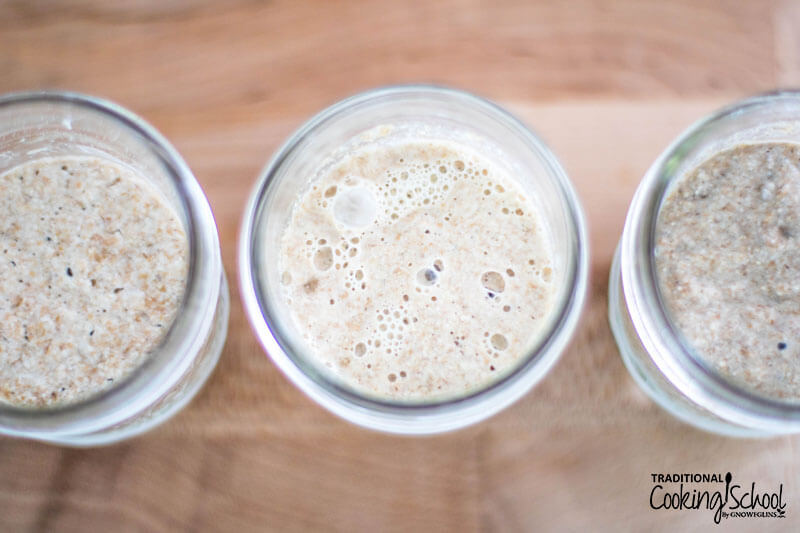
Can I feed my starter once a day instead of twice?
Skipping creates a less powerful starter, so if you want a high-performing starter, it’s best to feed twice daily, or more often in warm weather.
Can I feed my starter more than twice a day to build it up for baking?
Yes! You can feed your starter three, four, or five times a day. Just wait for it to show that it’s absorbing/using what was fed (it should be domed and bubbly) before feeding again. So that way you can build up quite a bit in a day if you need to.
How long after feeding starter can it be used?
Ideally, you should let your starter sit for a good 7 to 8 hours after feeding. However, you can use it in 3 or 4 hours in a pinch. Just keep in mind not all of the flour will be soured.
What is the minimum amount of flour I can feed my starter?
With 1/2 cup or less of starter, the minimum amount is a tablespoon or 2 of flour. With larger amounts of starter, the need to feed more increases.
If you notice it’s going through food faster, producing hooch sooner, or it isn’t as active… you underfed it, so increase next time.
What is the maximum amount of flour I can feed my starter?
As a general rule, never feed the starter more flour than three times its volume. If you have 1 cup starter, don’t feed it more than 3 cups flour (and 3 cups water). If you have 2 cups starter, don’t feed it more than 6 cups of flour (along with the 6 cups of water).
I need a break from my sourdough starter! What should I do?
You have a few options. You can move it to the fridge, which will slow down its activity. Ideally, take it out once a week to feed it and then move it back to the fridge, but if you forget or go on vacation, it can stay like that for weeks or even months.
Or, you can dehydrate and freeze it for long-term storage! Learn about that here.
Can I use my sourdough starter straight from the fridge?
Can you take your starter straight out of fridge (w/o recent feeding) and add it to fresh ground wheat? Will it work? -Chris @VitalFoundations
Yes. I do this after taking a sourdough starter break (where it’s stored in fridge). Get it out, feed it. After 12 hours, if it’s bubbly, it’s ready to be used. If you want to see more activity, feed again before using.
A starter stored for months won’t bounce back as quickly as one stored for days or weeks.
My starter has been in the fridge and is covered with a black liquid. Is it safe to use?
I have a starter that’s been in the fridge for eight months. Now it’s covered with a thick black liquid. Is it okay? What should I do with it? -Traci @WholesomeLiving
Yes. It’s hooch. It looks yellow at first, and gets blacker over time. It’s the acids produced by the organisms. Pour it off, feed your starter regularly, and it will revive! It can take days or even a few weeks to be fully active and strong again, depending on how long it has been dormant in the fridge.
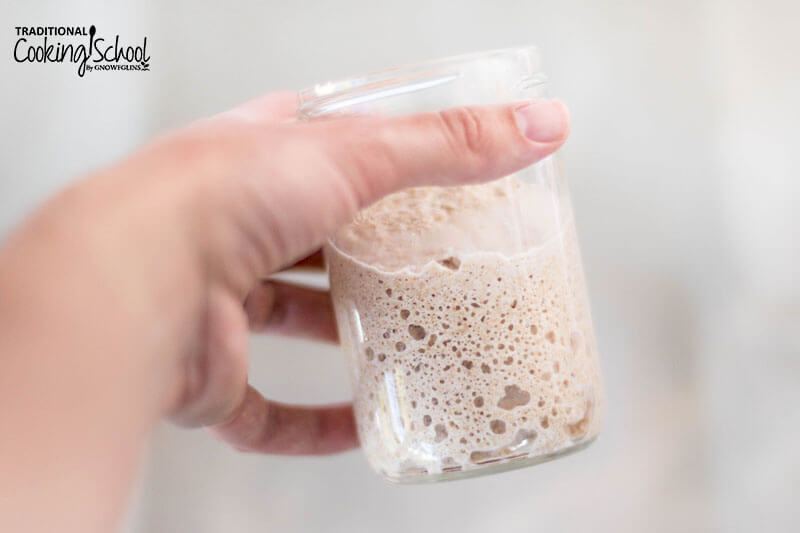
I live at a high altitude. Do I need to do anything differently when baking with sourdough?
Yes! Here is our recommended resource for high altitude baking.
How long should I sour my dough?
In general, the longer the souring time, the better for nutrition. We recommend a souring time of at least 7 to 8 hours at room temperature, or overnight for most sourdough recipes, but you can go up to 24 hours, too. Whether you do will depend on the recipe (and if you like a strong “sour” taste).
For example, it’s best not to exceed about 8 hours of souring time for doughs that need to be rolled out, such as tortillas or pizza crusts. Otherwise they will lose elasticity and break when stretched. This is less of an issue when your temperature is cool; you can go longer with no bad results.
My sourdough is too “sour” for me. Is there anything I can do?
Yes! There are several things you can do. Try feeding more frequently, especially in hot weather, and/or move your starter to a cooler place. You can also pour off the hooch before using your starter in recipes — the hooch is where the sourness from the Lactobacilli bacteria resides.
I share more tips to prevent “too sour” sourdough in this article.
Is sourdough nutrient-dense?
Is sourdough considered a nutrient-dense food? -Tami T.
Hmmm…. not really. It’s a healthy part of a nutrient-dense diet but it’s not one of the superfoods like liver, fermented foods, butter, cream, etc.
Is sourdough gluten-free?
No, although the gluten protein will be degraded by the sourdough process, making it easier to digest. Some sensitive individuals will still have trouble with it though. This post goes into why regular sourdough is not gluten-free in much more detail.
And, of course, some sourdough is gluten-free! Here is a run-down of gluten-free sourdough baking, plus how to make a gluten-free sourdough starter!
How do I know it’s okay to re-introduce gluten to someone who has a gluten sensitivity?
How did Wardee know her daughter could eat the gluten sourdough bread? My daughter is gluten sensitive-no celiac but afraid to try anything with gluten because she developed so many food allergies. She got some treated (natural method) so she can eat most things now but dairy, gluten, new development of stomach bothering her after coconut anything now. So how do you know it’s okay to try? -Gaylene K.
Is soaking of grains always less effective than sourdough or sprouting?
Is soaking still less effective even when using an acid medium, than souring or sprouting? I have a soaked kamut tortilla recipe that we really like. It does only use 1 T of ACV for the 3 cups of kamut used. -Tami T.
Yes, soaking is still less effective. (And soaking often involves an acid, except with nuts and beans.) You might try using 1 tablespoon of sourdough starter in your recipe to get the benefits of sourdough in a recipe you like.
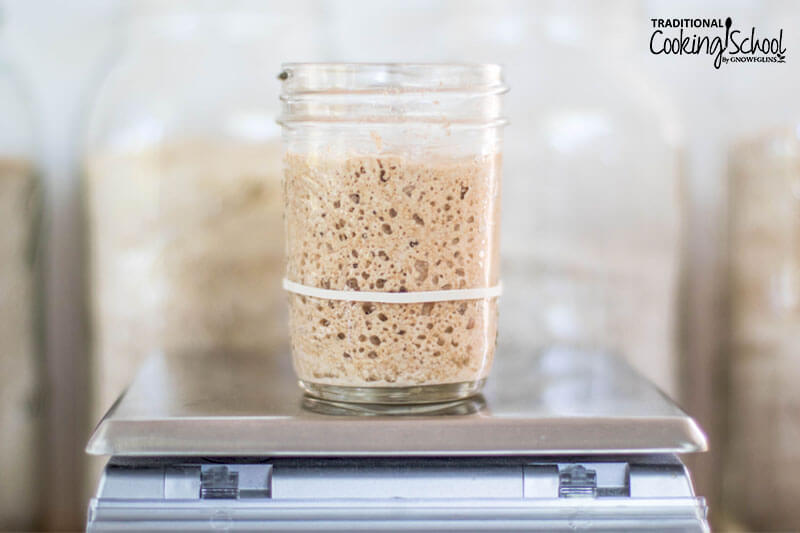
Is converting recipes to sourdough possible?
Yes! There are a few rules of thumb, depending on whether you want to convert a yeasted bread; quick bread; or waffles, pancakes, or crepes to sourdough. I share more tips for the sourdough conversion process in this #AskWardee.
Should I avoid all grains?
Many experts recommend a permanent avoidance of gluten and grain. If your gut is healed, do you personally feel this is necessary? I think I know the answer but would enjoy hearing you discuss it! -Tami T.
This is not one-size fits all. Some may avoid it for their entire lives because if they start again, symptoms return. For others, light-moderate consumption works and they still maintain a healthy gut.
Our experience has been that we can return to light-moderate consumption. That doesn’t mean it works for all!
I’d definitely say that one should sprout and/or sourdough for the best chance of not having a recurrence of symptoms or sliding backward on healing. And take it slowly… Eat a small amount and watch for a few hours to a few days before maybe having more (or not).
Did you find these sourdough troubleshooting tips helpful? Do you have any more questions we can answer? If so, feel free to leave a comment below!
Links Mentioned
- Free Sourdough Starter Instructions
- Free Traditional Cooking Video Series
- What’s your daily sourdough routine? #AskWardee 018
This post is a combination of two posts originally published and written by Wardee Harmon on 12/19/14 and 6/24/16. The posts were combined, updated, and republished on 6/23/21.
...without giving up the foods you love or spending all day in the kitchen!

2 free books:
Eat God's Way
Ditch the Standard American Diet, get healthier & happier, and save money on groceries...
We only recommend products and services we wholeheartedly endorse. This post may contain special links through which we earn a small commission if you make a purchase (though your price is the same).


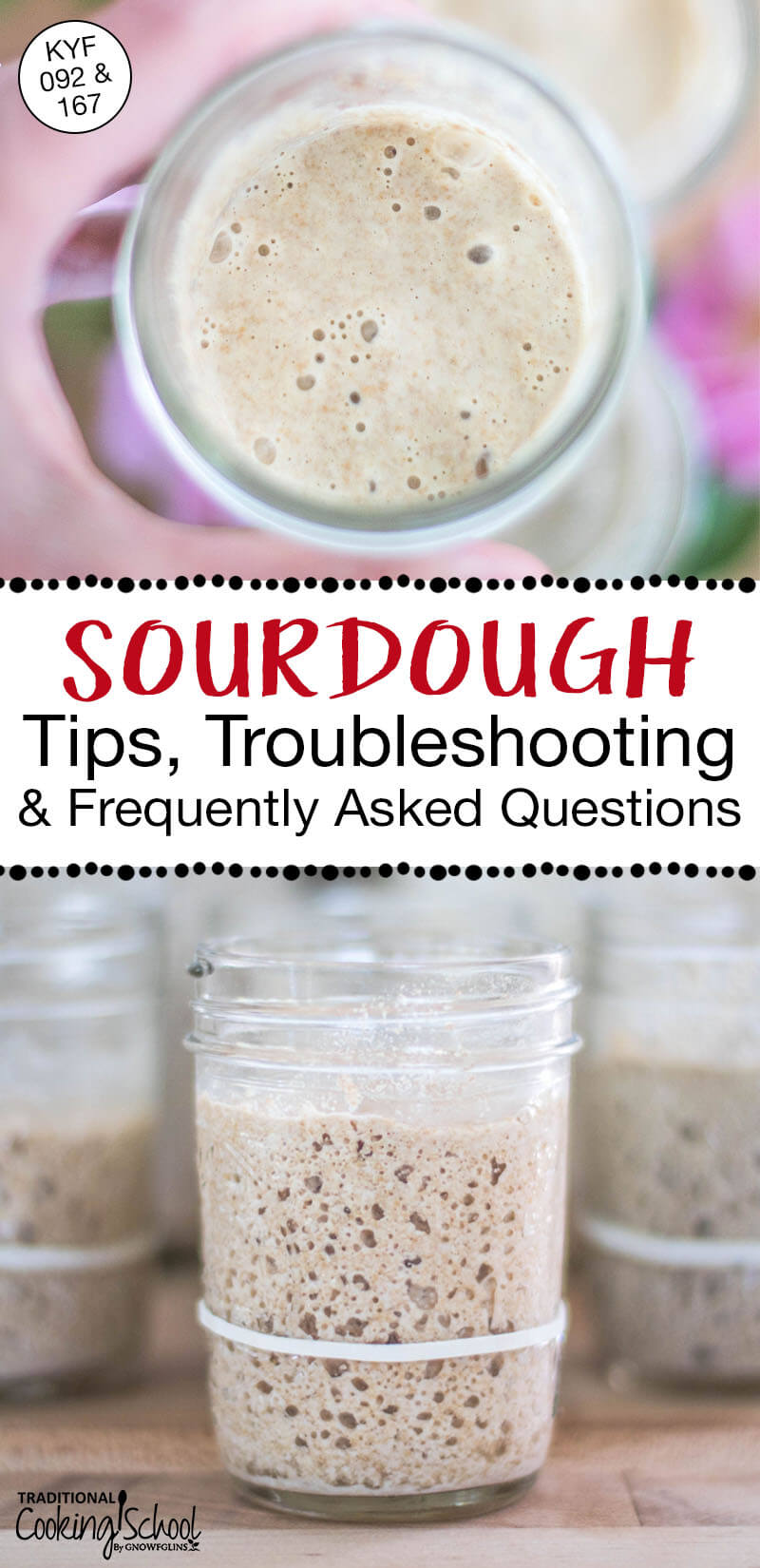
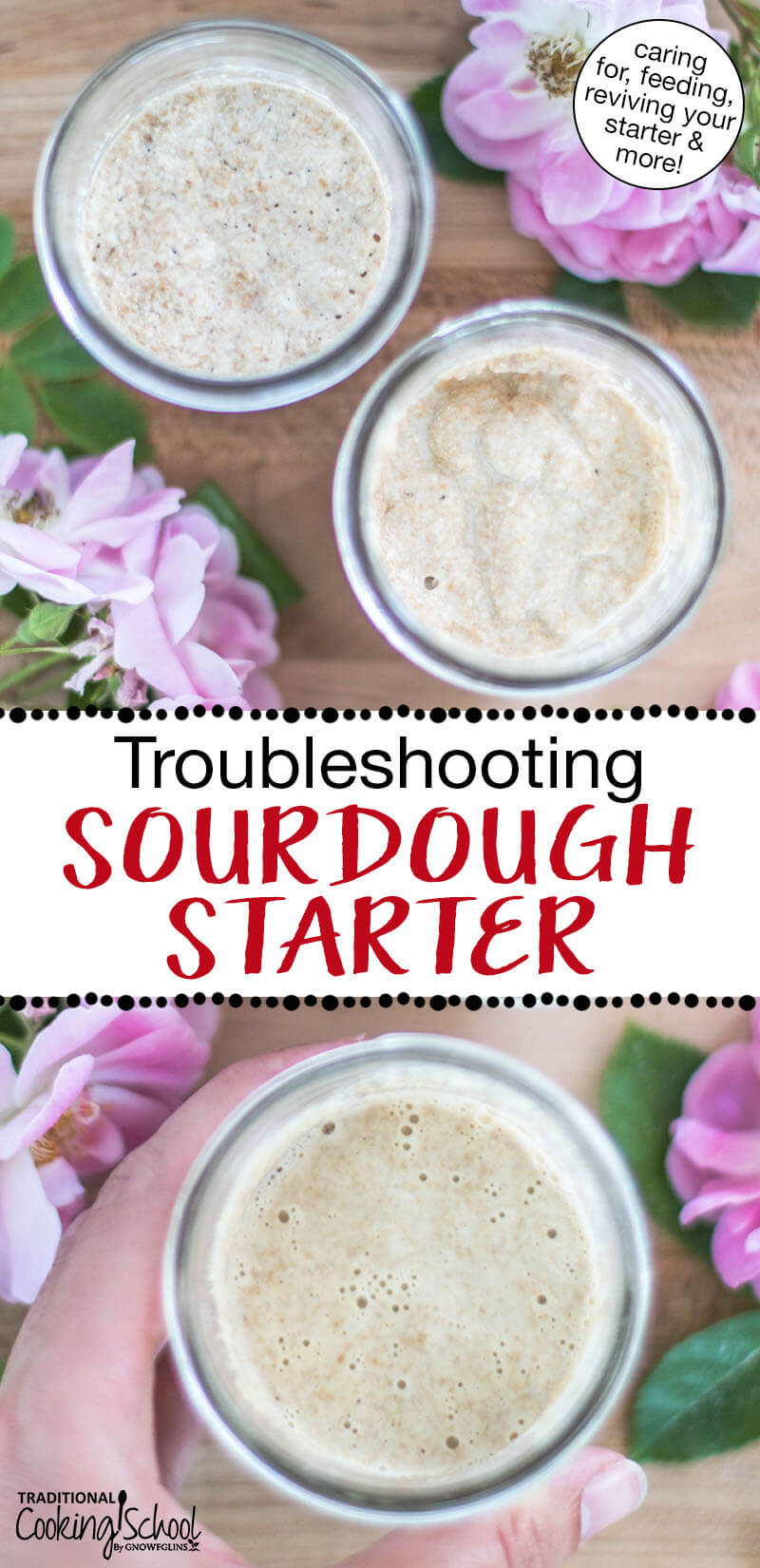
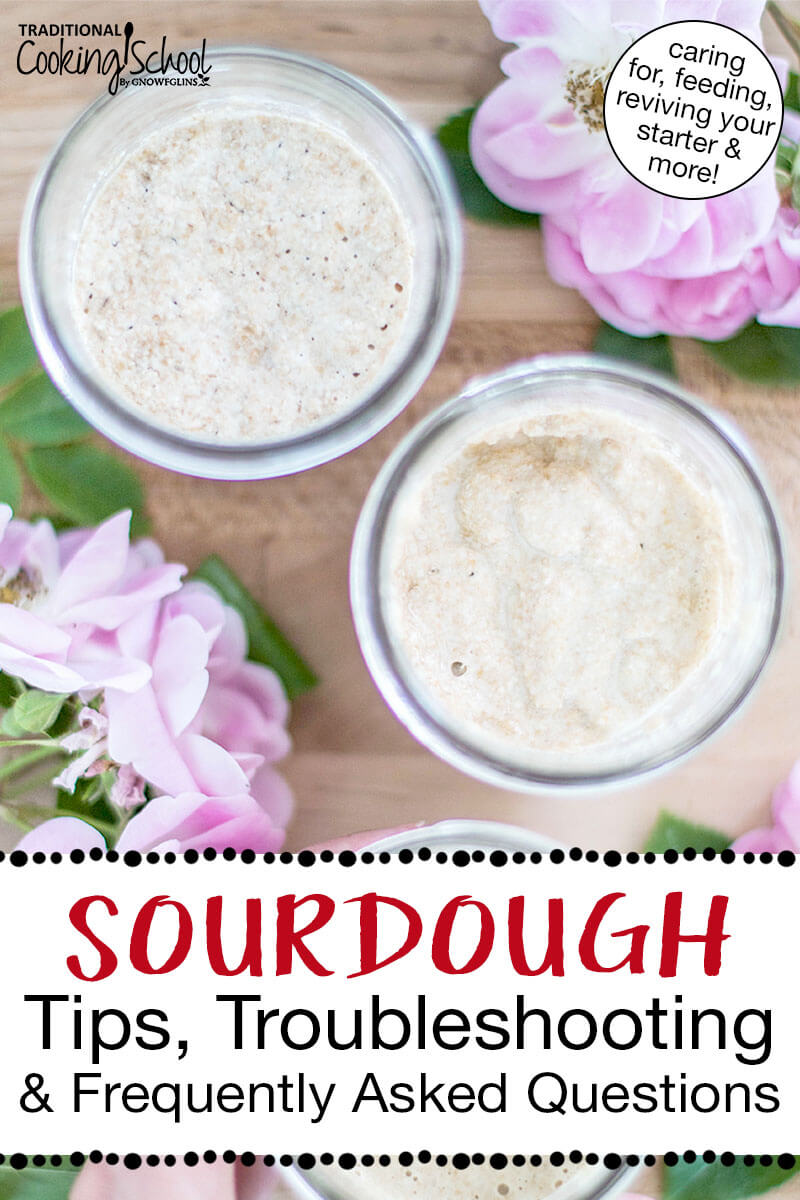
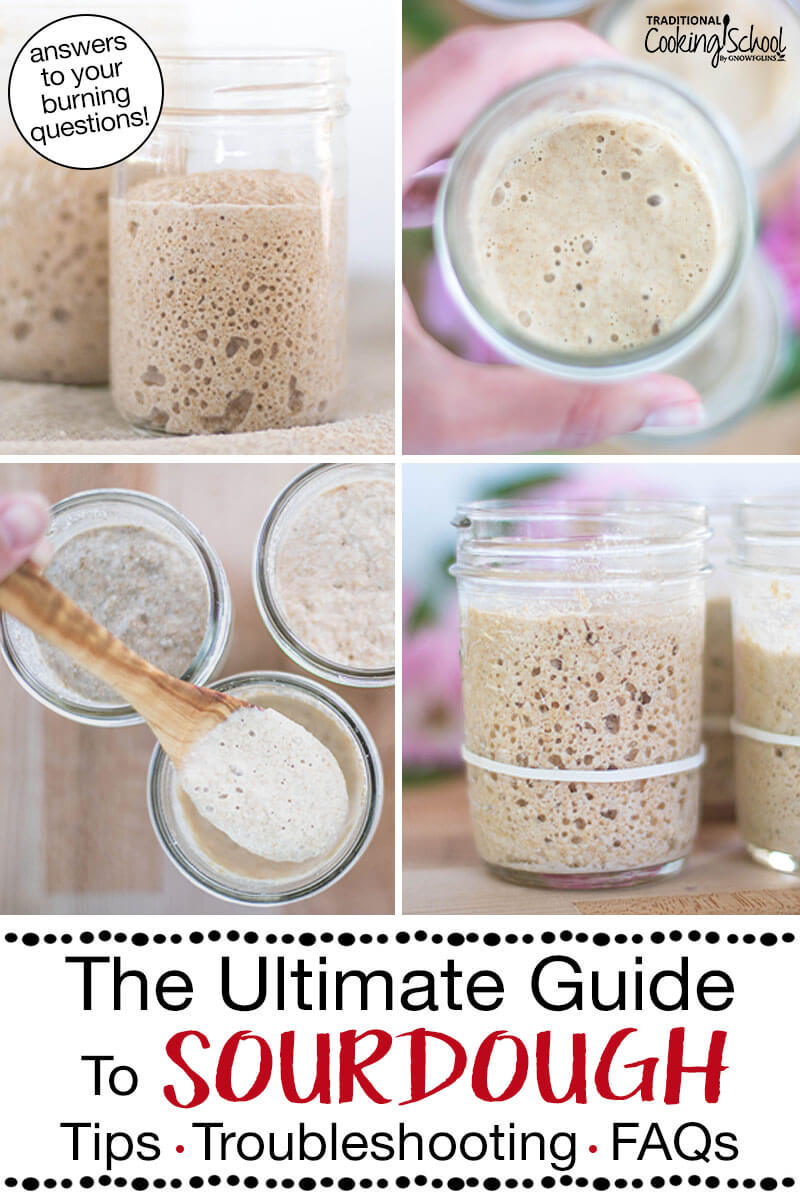
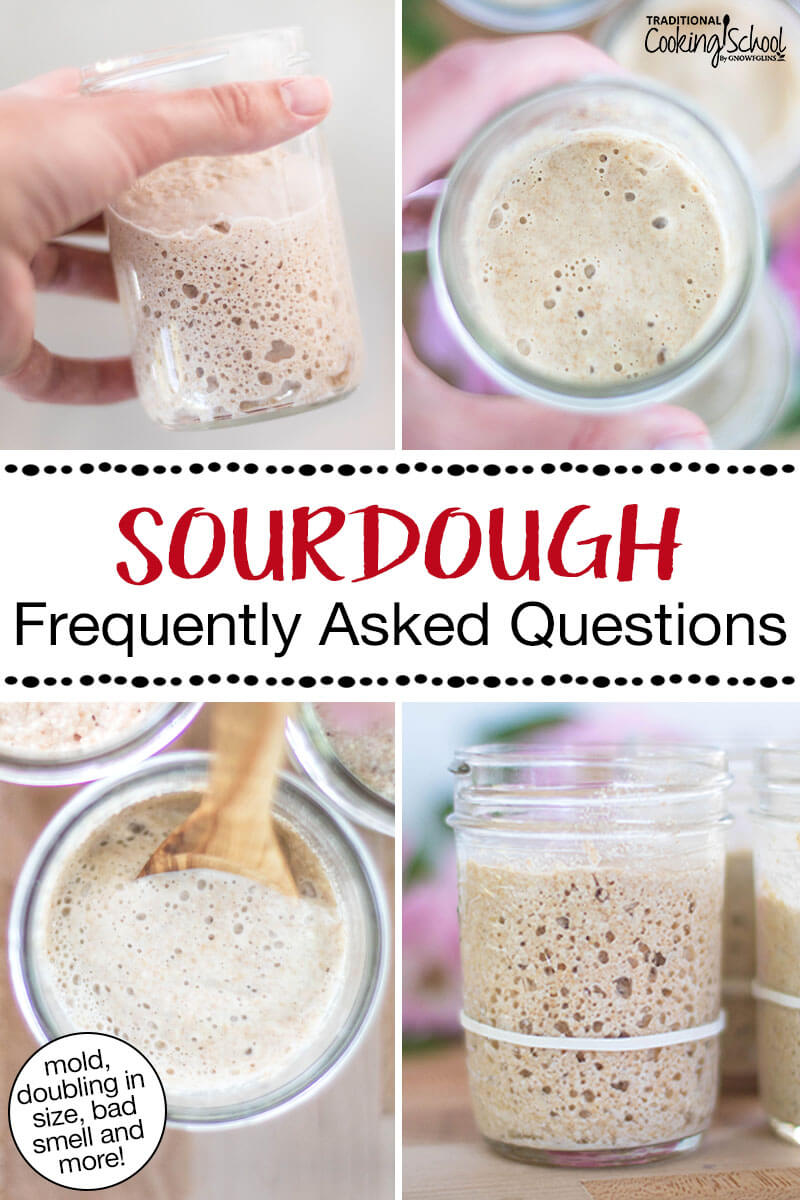
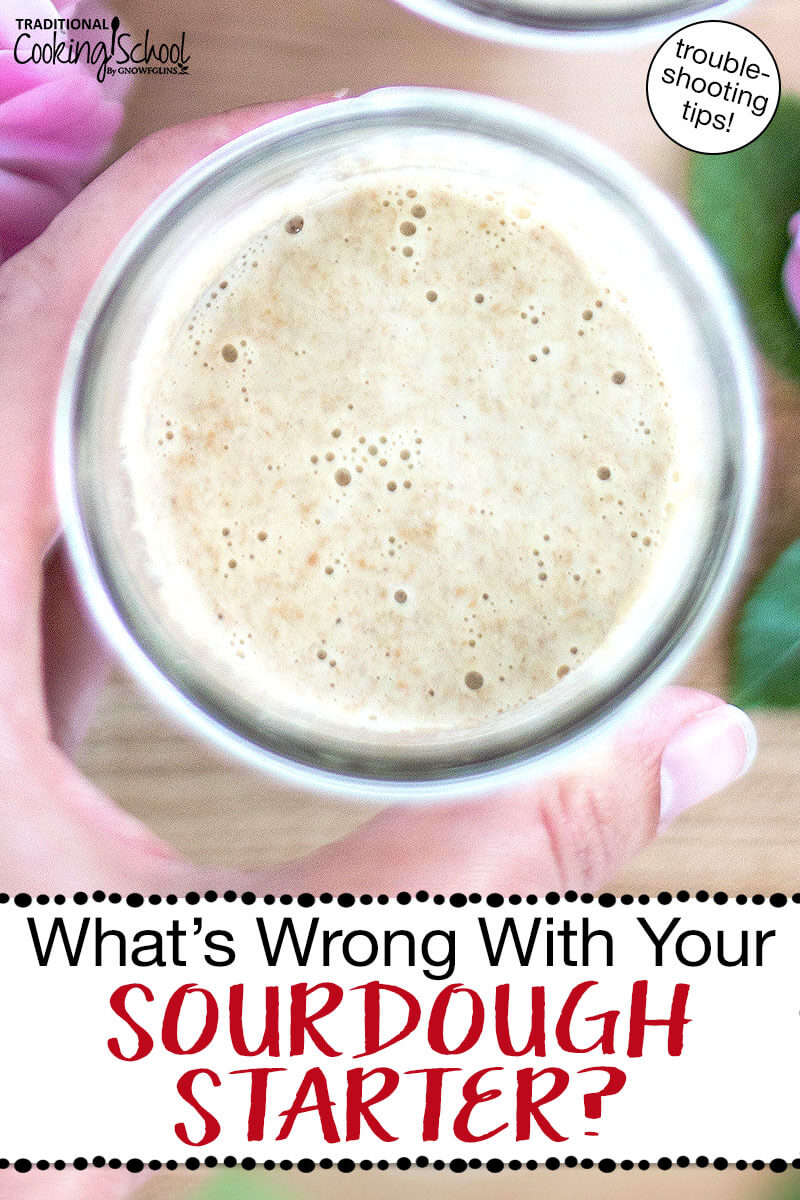
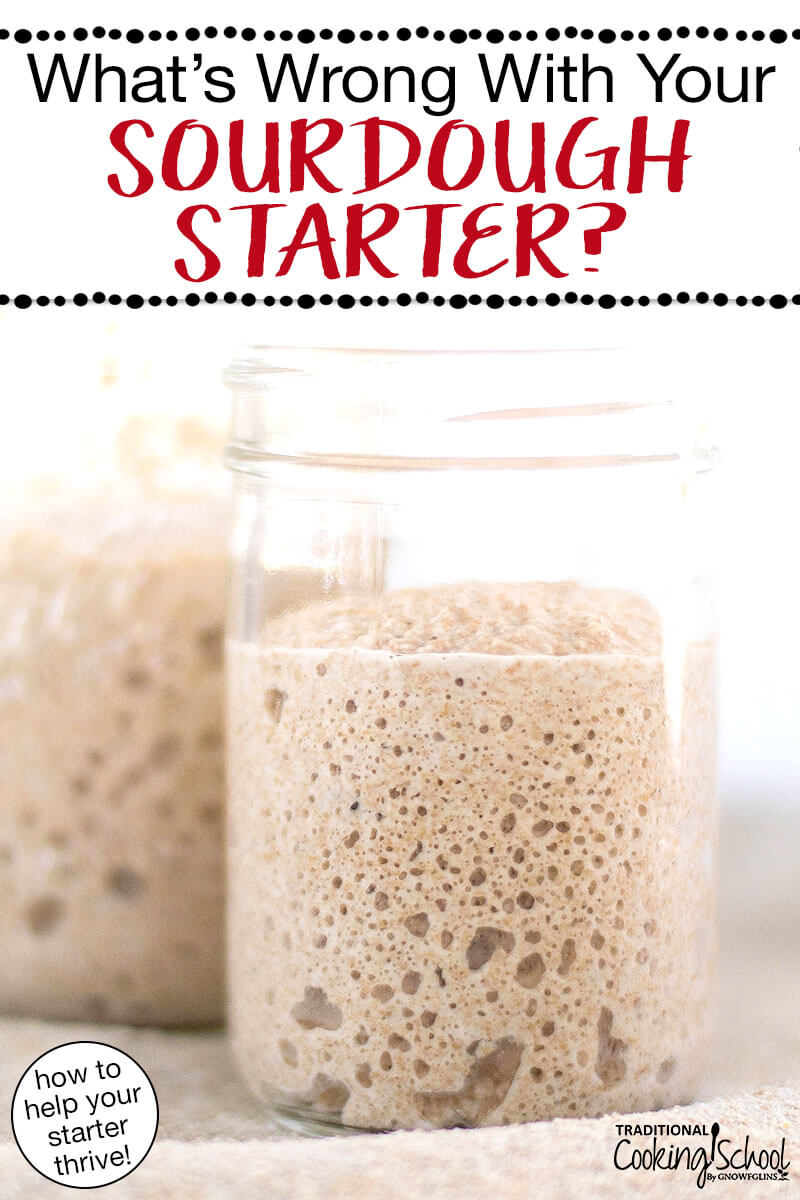
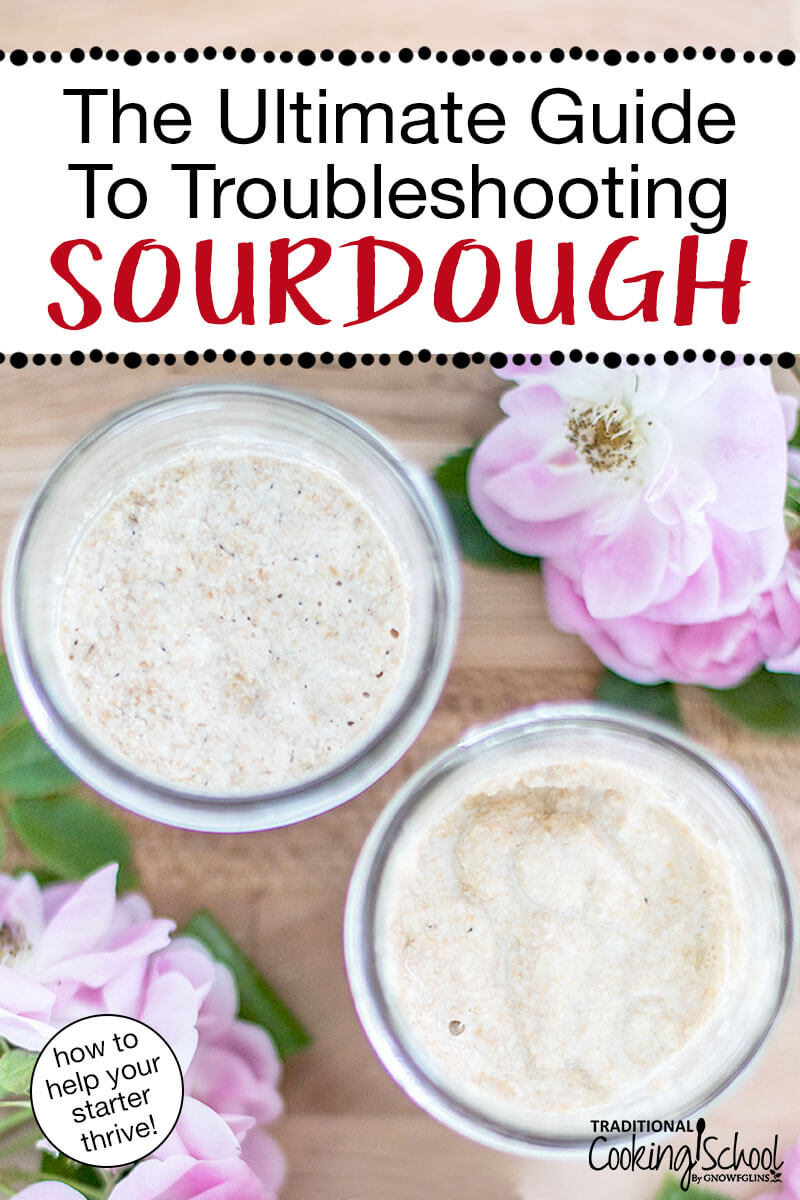
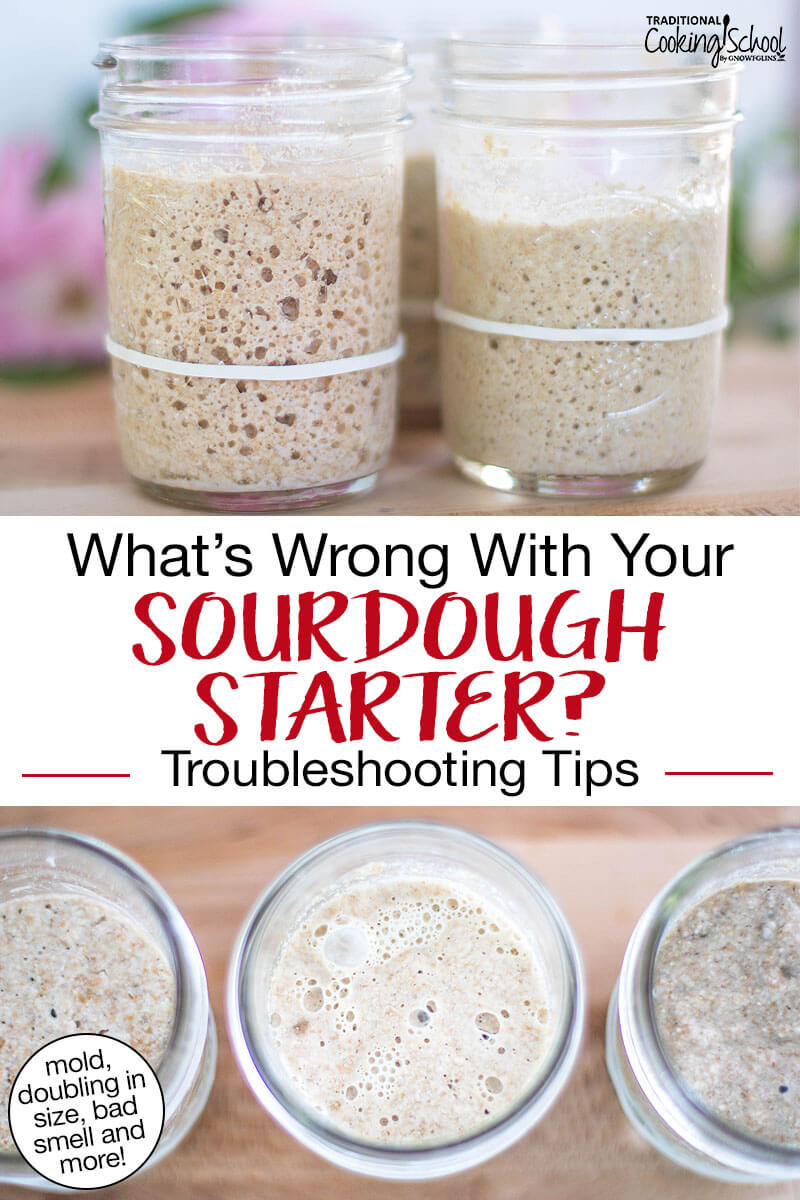
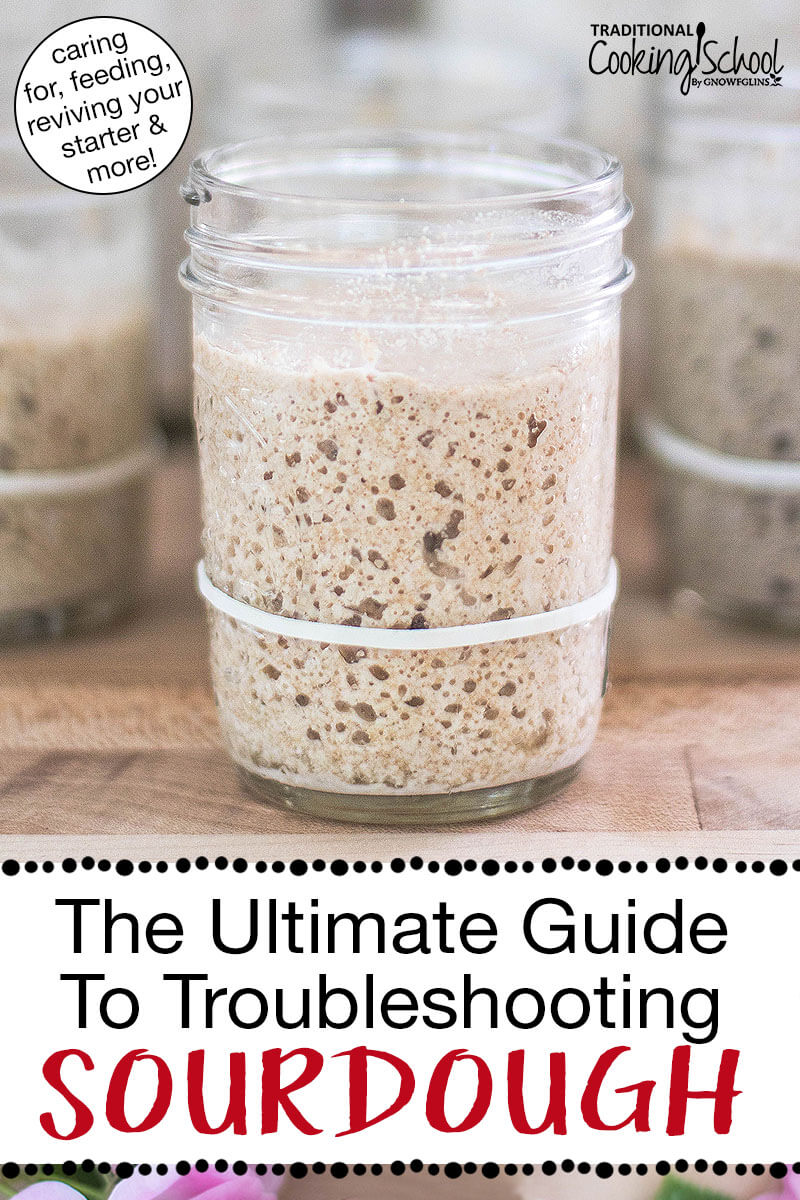
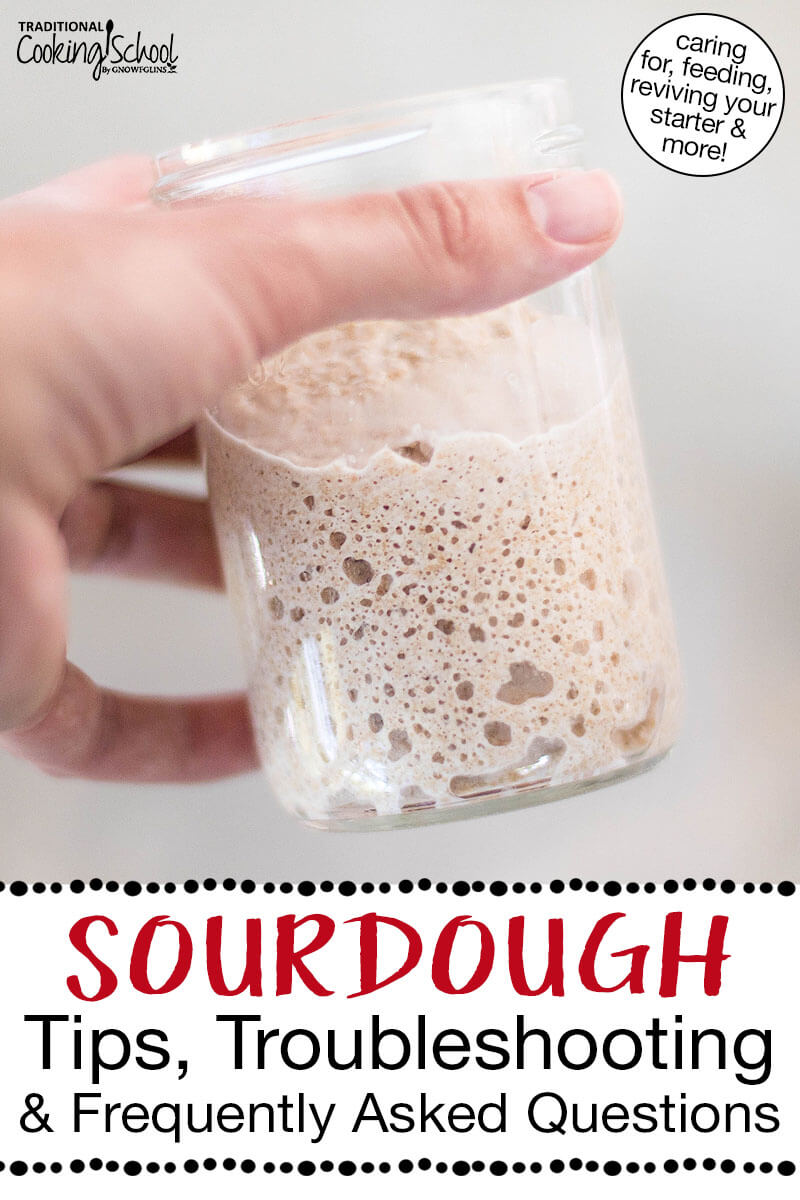
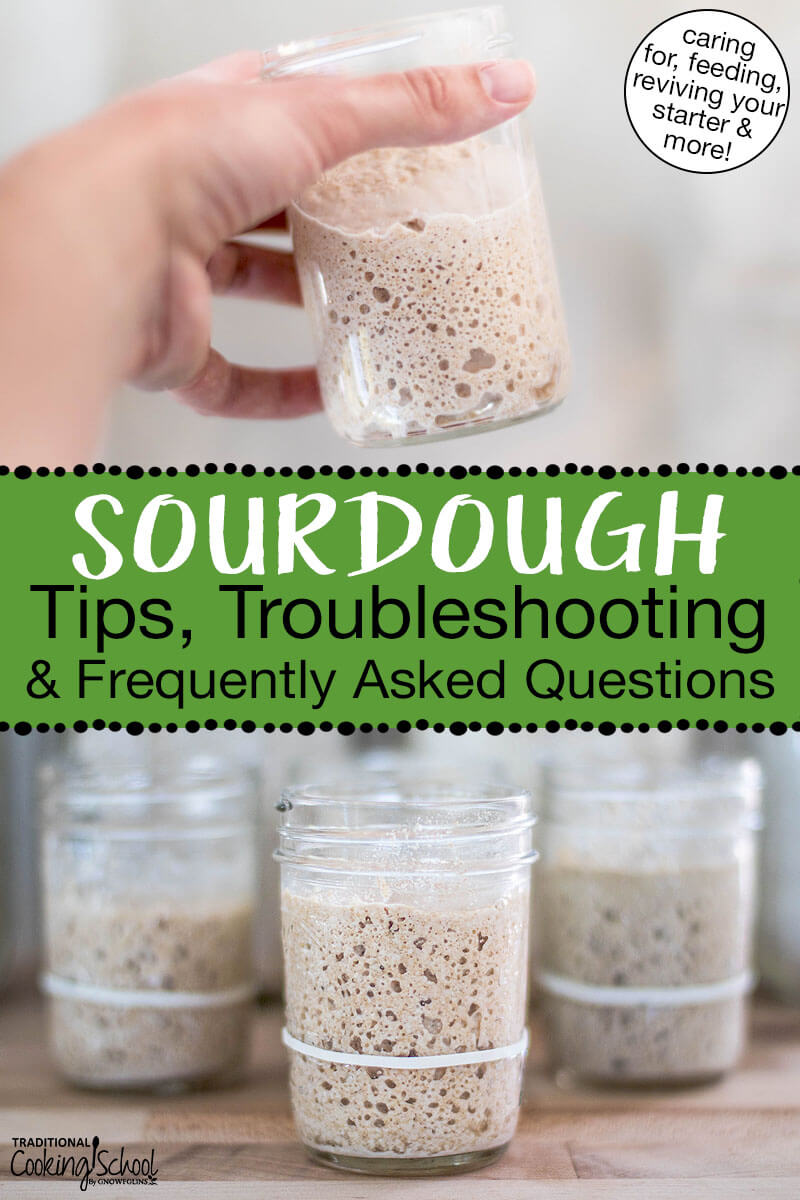
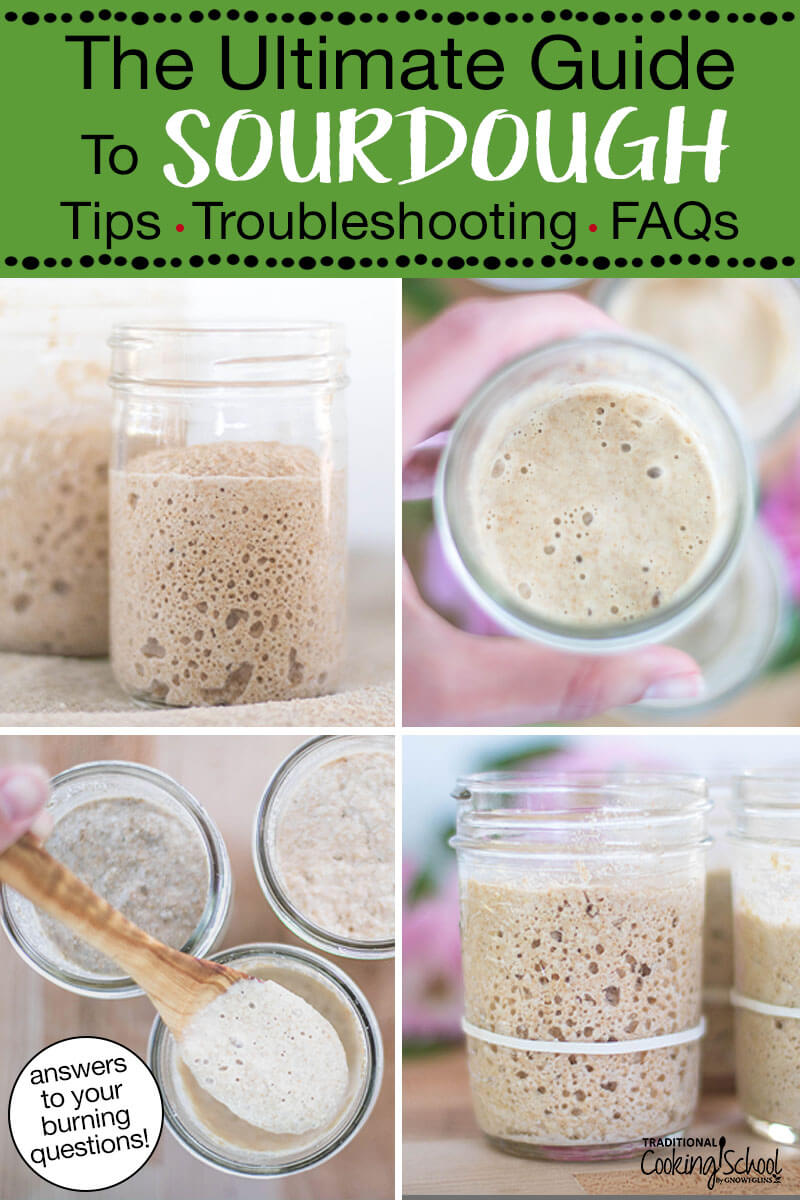
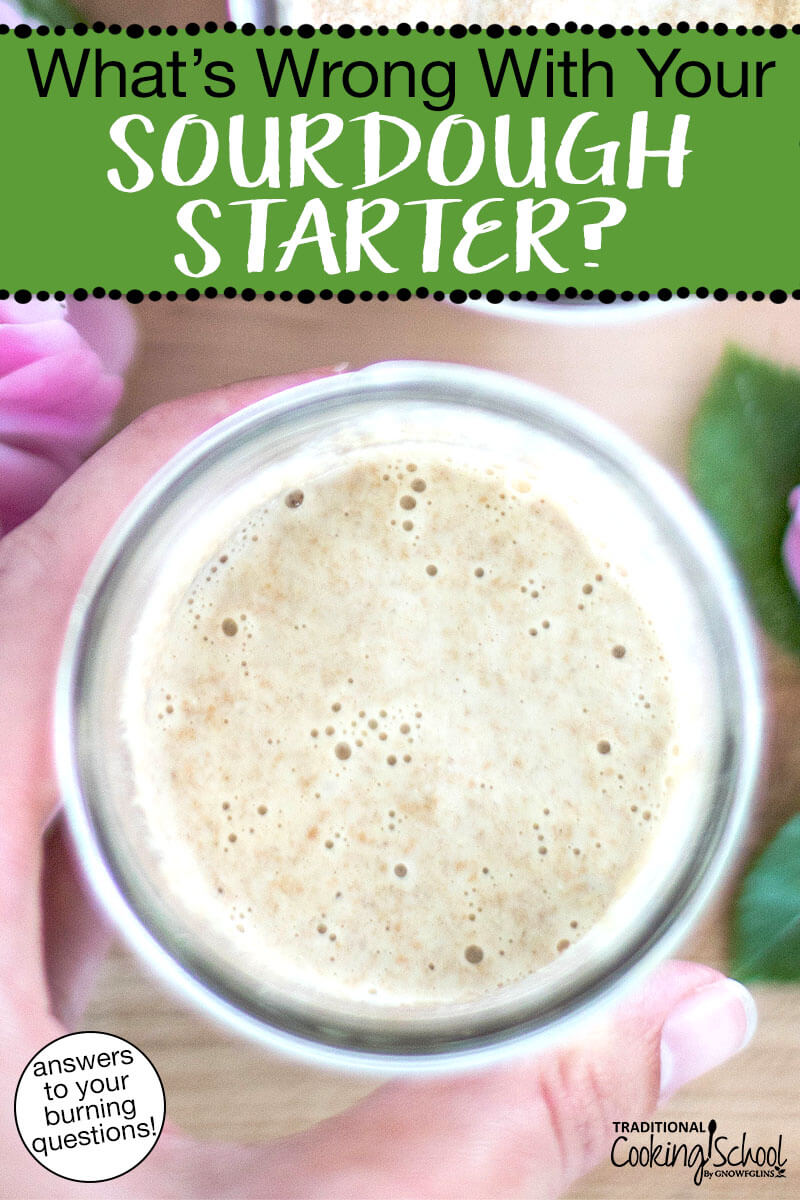
Hi Wardee
I just recently read your sour dough starter segment and am very interested this. I’m starting to have tummy troubles and nausea. I’m not sure if the thyroid pills I’m taking are causing it or not. I have been grinding my wheat kernels into flour. My w.w. Bread recipe calls for an additional 3 tablespoons of gluten flour and dough enhancer and 3 tablespoons of rapid yeast which seems like a lot. If I use a sour dough, would I have to use all that gluten and yeast?
i buy sourdough bread from a reputable chain bakery/cafe…they claim to use authentic sourdough starter, is this a good substitute for making my own?, ty
Hi Florence,
It may be or it may not be. 🙂
We have a new article that gives you questions to ask to make sure you are getting a sourdough with all of the health benefits it should have — > https://traditionalcookingschool.com/2017/01/11/is-store-bought-sourdough-true-sourdough-aw057/
Millie
Traditional Cooking School Support
My no knead sour dough is too sour.
How can I make less sour bread?
Hi Mark,
We have another post on that very subject here: https://traditionalcookingschool.com/fermenting-and-culturing/sourdough/6-tips-to-prevent-sour-sourdough/
~ Vicki, TCS Customer Success Team
I have a ‘Herman’ or Amish Friendship bread starter going. Can I use it, the same as your sourdough, such as for the chocolate cake recipe?
Hi Joanne, we have not made or used amish friendship starter so we can not confirm you will have the same results if you use this starter.
We recommend using a sourdough starter that is only flour and water. The amish friendship starter usually contains commercial yeast and sugar.
~ Vicki, TCS Customer Success Team
My einkorn starter is mature and I want to make the einkorn no knead bread. How long after feeding the starter should I use it in the bread recipe?
Thanks!
Hi Simone,
How exciting! You will want to wait 7-12 hours depending on the temperature of your home and it should be bubbly and active. Happy baking! ~Peggy, TCS Customer Success Team
Hello! I started a sourdough starting using your recipe and It’s about two weeks old. It’s producing bubbles but it’s never risen. I had it in a quart sized mason jar then moved it to a gallon size glass container so I could have more for baking. Do you keep your sourdough in the mason jar you start with? Also, what should I do now since it’s still not doubling. Can I remove some of it and put it back in the mason jar and discard the rest to sort of troubleshoot it?
When starter has peaked after doubling in size,but then shortly collapsed.
What’s the next step to do?
Use,feed,put in frig?
New to this.
Thank you.
Yes, you would use it then or put it in the refrigerator if you’re not planning to feed/use soon. ?
~Danielle, TCS Customer Success Team Lead
Hi Wardee,
I’m new to your site and to sourdough everything.
I’m trying for a second time to make the sourdough starter with your method.
Both times looked beautiful for the first three feeding and after that, the starter looks creamy, but nothing else. I threw away the first one after 10 days feeding and watching it.
Now it is the 5 day of the second time and there seem like 5-7 mini bubbles in the entire “cream”… What am I doing wrong?
Hi, Naidy,
You may want to check the quality of your flour and the temperature of your home. We provide full troubleshooting help in our Sourdough Masterclass. We would love to get you the help you need to start making sourdough everything. 🙂
Here is the link to sign up: https://traditionalcookingschool.com/868w
~Peggy, TCS Customer Success Team